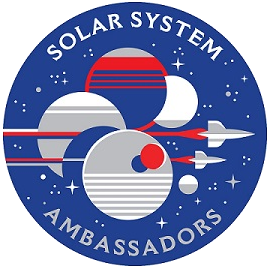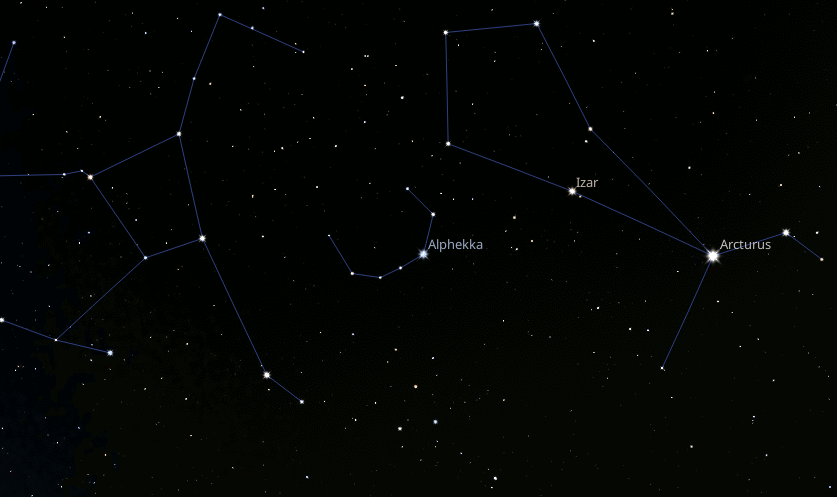This is the companion Web Site of Bob Moler's Ephemeris radio program, which is broadcast Monday Through Friday on Interlochen Public Radio Stations. Interlochen Public Radio serves northwestern lower Michigan. The first Ephemeris program was broadcast June 1, 1975.I started with another weekly program (Moler’s Universe) on IPR 11 months earlier in July, 1974. Celebrating 50 years producing programs for IPR! Click on the above link for live streaming audio from IPR. Or download the Interlochen Public Radio app from the Apple App Store or Google Play.Bob Moler's Ephemeris Blog contains scripts and illustrations for the Ephemeris programs. They are generally released at 12:01 a.m. Eastern Time on the program play date. |
||
NASA/JPL Solar System Ambassador –----- Contact me at the email address at the bottom of this page to discuss star parties and presentations for schools, scout groups, and non-profit organizations in person or via Zoom. –----- That being said, opinions expressed on this website are my own and not that of NASA or JPL Ephemeris Radio Schedule Monday - Friday 6:19 & 8:19 a.m. - News stations 7 a.m.- Classical stations The Stations of Interlochen Public Radio WIAA 88.7 FM Caberfae W234BU 94.7 FM Traverse City WLNM 89.7 FM Manistee, Ludington WHBP 90.1 FM Harbor Springs, Petoskey Note that scripts for the programs plus illustrations and additional information are part of my Ephemeris blog, which can be clicked on above. Observing Weather in Northwestern Lower Michigan
|
April 2025 Interested in learning more about astronomy or the night sky? If you live in northwestern lower Michigan check out the Grand Traverse Astronomical Society. More information on visible planetary and other events are available on Bob Moler's Ephemeris Blog the day of the event. The blog contains Monday-Friday program scripts, most with illustrations and additional information. I dug through the IPR web archives and found these: Bob Moler looks back at 40 years of 'Ephemeris'June 2024: It's still 'an amazing ride,' after 50 years exploring the cosmos on IPR-------------- Extra! My report on the Great American Eclipse of August 21, 2017, with added animated GIF of the sky at the totally eclipsed Sun, watching the shadow pass over. Planetary Highlights for April 2025 (ET) Date Time Event
Apr 1 Tu Venus: 16.3° W
1 Tu 4:28 PM Moon-Pleiades: 0.6° S
3 Th 6:15 PM Moon North Dec.: 28.7° N
4 Fr 10:14 PM First Quarter
5 Sa 12:46 PM Moon-Pollux: 2.1° N
5 Sa 3:04 PM Moon-Mars: 2.3° S
6 Su 12:44 PM Moon-Beehive: 2.8° S
8 Tu 7:51 AM Moon-Regulus: 2.4° S
10 Th 8:19 AM Mercury-Saturn: 2.1° N
10 Th 3:56 PM Moon Descending Node
12 Sa 8:22 PM Full Moon
12 Sa 9:39 PM Moon-Spica: 0.4° N
13 Su 6:48 PM Moon Apogee: 406300 km
16 We 6:19 PM Moon-Antares: 0.4° N
18 Fr 9:24 AM Moon South Dec.: 28.6° S
20 Su 9:35 PM Last Quarter
21 Mo 2:59 PM Mercury Elongation: 27.4° W
22 Tu 8:53 AM Lyrid Shower: ZHR = 20
24 Th 9:21 PM Moon-Venus: 2.4° N
24 Th 10:23 PM Moon Ascending Node
25 Fr 12:15 AM Moon-Saturn: 2.3° S
25 Fr 9:05 PM Moon-Mercury: 4.3° S
27 Su 12:15 PM Moon Perigee: 357100 km
27 Su 3:31 PM New Moon
28 Mo 3:27 PM Venus-Saturn: 3.7° N
29 Tu 2:35 AM Moon-Pleiades: 0.5° S
May 1 Th Venus: 40.9° W
Sky Events Calendar by
Fred Espenak and Sumit Dutta (NASA’s GSFC),with
modifications. If you go to the above site you can print out a list like the above for the entire year or calendar pages for your time zone. Note that the site is now kept up for archival purposes. Fred Espenak retired from NASA several years ago and has his own site, AstroPixels, which contain much of the same information in a slightly different format: http://astropixels.com/almanac/al bmanac.html. However, he doesn’t adjust for Daylight Saving Time. To use DST select times from the time zone just east of your time zone. Looking Ahead T Coronae Borealis is expected to erupt as a nova Real Soon Now
When? Any time now. A small but easily spotted constellation of Corona Borealis, the Northern Crown can be spotted year round. Though not far north enough to be circumpolar. At worst case it can be seen low on the horizon before sunrise or after sunset. It is located near the kite shaped constellation of Boötes, with its bright star Arcturus at the right. The Northern Crown is a three-quarter circle of stars, like a tiara, with a brighter star Alphecca at the bottom. Alphecca in Arabic means “The bright star of the broken ring of stars”, which is an accurate description of it. Check it out now for later this or in the next year or two we expect to have a bright star appear just below it. That star is T Coronae Borealis ( T CrB) a recurrent Nova or exploding star. They occur when a white dwarf star is orbiting with a large red giant star and accumulating gas from that red giant star until the accumulated material explodes. This happens again and again. In this stars case, about every 80 or so years. Though it was forecast for last year, I'm still betting on 2026. (No, I won't put any money on it.) |
Free SoftwareStellarium is a fabulous planetarium program with a very realistic sky and simple controls. They've added some features in the latest version (24 .3) and new rendering engine that may not be compatible with older computers without using command line options. See the Stellarium User Guide (pdf) under Command Line Options for what to try. https://stellarium.org. Finally, after 20 years, it’s out of Beta testing. There’s a web based version of Stellarium. It’s pretty much bare bones, but works much like the computer version. It’s located here: https://stellarium-web.org. There is also a smart phone and tablet version both free and $. Cartes du Ciel (Sky Charts) is a great telescope companion. I use it to create finder charts for comets and calendar lists of twilight times for the monthly preview on my blog. I use it for my weekly look at the planet telescopic appearances. It can be downloaded from http://astrosurf.com/astropc/. Virtual Moon Atlas is a great tool for reference at the telescope or desk. http://www.astrosurf.com/avl/UK_index.html. Celestia is a great 3D simulator of solar system objects and beyond. However it has not been updated in a while. http://www.shatters.net/celestia/ Hallo Northern Sky is an interesting planetarium program. It seems not as polished as Stellarium, but has some cool features. I use it when planning star parties as a quick way to see what would be visible because it loads quickly. http://hnsky.org/ |
Ephemeris - Years on the air: 49 (Since June 1975) Years on the Internet: 29 (Since September 1995)
Email: brelom@gmail.com
|
||

